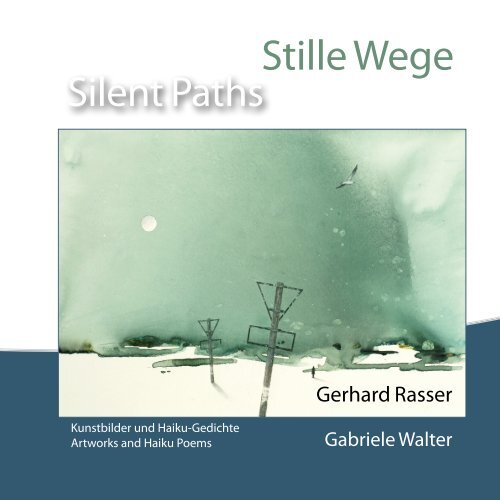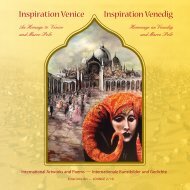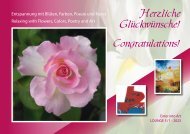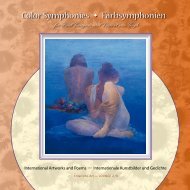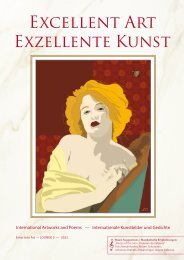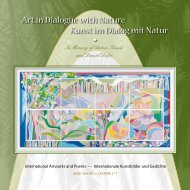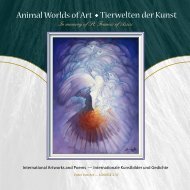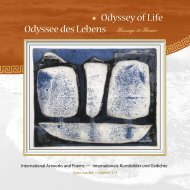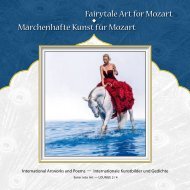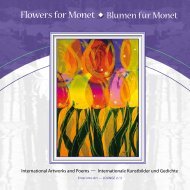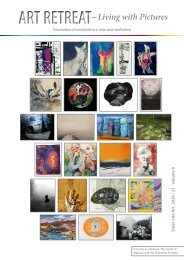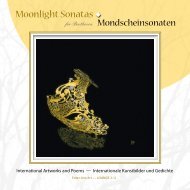Stille Wege - Silent Path - Gerhard Rasser, Gabriele Walter
Von der Stille wird gesagt, in ihr sei der weite Atem der Ewigkeit. Mit ihrem klaren, von Einschränkungen befreiten Blick sind Gerhard Rassers Bilder Verweilstätten der Ruhe. In unserer von Medienlärm geprägten Zeit laden sie zum Schweigen ein. Das Einswerden mit dem schöpferischen und künstlerischen Weltganzen schaltet alles Unwesentliche aus. Pilgern Sie mit diesem Kunst- und Geschenkbuch zur inneren Mitte. Sie werden sehen - in der Stille ist noch Platz für neue Horizonte. Ebenso wie Haiku und japanische Tuschebilder erscheinen die Werke des am Bodensee lebenden Österreichers als auf wenige Elemente reduzierte Ausschnitte, klar konturiert vor dem Hintergrund des Unendlichen. Aus der Seele des Künstlers sprießt eine geheimnisvolle Kraft. Die enge Beziehung zwischen Kunst, Dichtung und Natur überträgt sich auf den Rezipienten. Gleich einem Haiga-Kunstwerk kann das Buch als Gesamtkomposition aus Bildhaftigkeit und Poesie begriffen werden, welches beim Durchblättern Ruhe und Freude verleiht, das Bewusstsein erweitert und die Sinne anregt. The printed book is available in the book trade and in internet bookshops. Hardcover: ISBN 978-3-96103-956-2, Publisher: Re Di Roma-Verlag, Language: English, German, Size: 21 x 21 cm Silence is said to contain the long breath of eternity. With their open, unimpaired views, Gerhard Rasser’s paintings are peaceful resting places. Amid the noise of our media-dominated times, they invite observers to pause and fall silent. As they become one with the creative, artistic cosmos of the world, they manage to turn off all unnecessary noise. Pick up this art and gift book, and see for yourself. Embark on a pilgrimage to the core of your being. Within its silence, you will discover new horizons. Just like haiku and Japanese ink wash paintings, the works of the Austrian resident of the Lake Constance area appear as clippings of truth reduced to its essentials, clearly outlined against the backdrop of eternity. From the soul of the artist springs forth a mysterious power. The close connection between art, poetry, and nature reaches the recipient by way of direct artistic transmission. As in haiga art, this book is a composition of images and poetry that affords peace and quiet to those leafing through it, while expanding their consciousness, and stimulating their senses.
Von der Stille wird gesagt, in ihr sei der weite Atem der Ewigkeit. Mit ihrem klaren, von Einschränkungen befreiten Blick sind Gerhard Rassers Bilder Verweilstätten der Ruhe. In unserer von Medienlärm geprägten Zeit laden sie zum Schweigen ein. Das Einswerden mit dem schöpferischen und künstlerischen Weltganzen schaltet alles Unwesentliche aus. Pilgern Sie mit diesem Kunst- und Geschenkbuch zur inneren Mitte. Sie werden sehen - in der Stille ist noch Platz für neue Horizonte. Ebenso wie Haiku und japanische Tuschebilder erscheinen die Werke des am Bodensee lebenden Österreichers als auf wenige Elemente reduzierte Ausschnitte, klar konturiert vor dem Hintergrund des Unendlichen. Aus der Seele des Künstlers sprießt eine geheimnisvolle Kraft. Die enge Beziehung zwischen Kunst, Dichtung und Natur überträgt sich auf den Rezipienten. Gleich einem Haiga-Kunstwerk kann das Buch als Gesamtkomposition aus Bildhaftigkeit und Poesie begriffen werden, welches beim Durchblättern Ruhe und Freude verleiht, das Bewusstsein erweitert und die Sinne anregt.
The printed book is available in the book trade and in internet bookshops. Hardcover: ISBN 978-3-96103-956-2, Publisher: Re Di Roma-Verlag, Language: English, German, Size: 21 x 21 cm
Silence is said to contain the long breath of eternity. With their open, unimpaired views, Gerhard Rasser’s paintings are peaceful resting places. Amid the noise of our media-dominated times, they invite observers to pause and fall silent. As they become one with the creative, artistic cosmos of the world, they manage to turn off all unnecessary noise. Pick up this art and gift book, and see for yourself. Embark on a pilgrimage to the core of your being. Within its silence, you will discover new horizons. Just like haiku and Japanese ink wash paintings, the works of the Austrian resident of the Lake Constance area appear as clippings of truth reduced to its essentials, clearly outlined against the backdrop of eternity. From the soul of the artist springs forth a mysterious power. The close connection between art, poetry, and nature reaches the recipient by way of direct artistic transmission. As in haiga art, this book is a composition of images and poetry that affords peace and quiet to those leafing through it, while expanding their consciousness, and stimulating their senses.
You also want an ePaper? Increase the reach of your titles
YUMPU automatically turns print PDFs into web optimized ePapers that Google loves.
<strong>Stille</strong> <strong>Wege</strong><br />
<strong>Silent</strong> <strong>Path</strong>s<br />
<strong>Gerhard</strong> <strong>Rasser</strong><br />
Kunstbilder und Haiku-Gedichte<br />
Artworks and Haiku Poems<br />
<strong>Gabriele</strong> <strong>Walter</strong>
<strong>Silent</strong> <strong>Path</strong>s<br />
<strong>Stille</strong> <strong>Wege</strong><br />
25 Haiku-Gedichte von<br />
25 haiku poems by<br />
<strong>Gabriele</strong> <strong>Walter</strong><br />
37 Kunstbilder von<br />
37 artworks by<br />
<strong>Gerhard</strong> <strong>Rasser</strong><br />
2 Enter into Art 2016 | 3
Vorwort<br />
Foreword<br />
In <strong>Gerhard</strong> <strong>Rasser</strong>s Kunstbildern regiert das<br />
Schweigen. Es ist ein Schweigen frei von Anspannung,<br />
ein Schweigen des Friedens. Entflieht man<br />
dem Lärm der Welt, kann man Ruhe und Erfüllung<br />
finden. Die <strong>Wege</strong> der <strong>Stille</strong> mahnen den Betrachter,<br />
nicht zu sprechen und ohne Hast zu schreiten.<br />
Obwohl in den Werken jede seelische Aufregung<br />
geglättet zu sein scheint, geschieht in ihren Leerräumen<br />
mehr, als sich vermuten lässt. Meister<br />
Eckehart meinte einst: „Wer alle Dinge empfangen<br />
will, der muss auch alle Dinge hergeben.“ Das ist,<br />
mit <strong>Rasser</strong>s Bildtiteln ausgedrückt, ein „Langer<br />
Weg“ geprägt von Verlockungen, Abgründen und<br />
Melancholie, ein Weg der Suche und des zaghaften<br />
Annäherns, ein Weg, auf dem man sich in fernen<br />
und neuen Welten verlieren kann.<br />
Einsamkeit dient dem Aufspüren und Verstehen<br />
der eigenen Persönlichkeit. Obwohl <strong>Rasser</strong>s<br />
Motive eher von nordischen Landschaften inspiriert<br />
sind, erinnern sie an die Zeit der Wüstenväter,<br />
an Einsiedelei und Eremitentum. Ein monotoner<br />
Choral hallt durch die <strong>Stille</strong> seiner Landstriche. Wer<br />
hineinhorcht, vermag es, sich zu sammeln - sich loszureißen<br />
vom Hamsterrad der Betriebsamkeit. Wer<br />
hineinblickt, spürt den Drang, dem engen Gehäuse<br />
einer festgefahrenen Weltsicht zu entkommen, den<br />
eingefahrenen Abläufen, den Verführungen, dem<br />
Lärm und auch sich selbst.<br />
Wer nicht zur Ruhe kommt, ist oft desorientiert.<br />
Obwohl <strong>Rasser</strong>s Protagonisten so winzig<br />
sind, dass man sie übersehen könnte, sind sie orientiert.<br />
Einsam wie Caspar David Friedrichs Mönch<br />
wandeln sie am Meer entlang, verlieren sich in der<br />
Weite der Landschaft und versinnbildlichen so die<br />
Bedeutungslosigkeit des Menschen im Verhältnis<br />
zum Kosmos. Ins Weite blickend gleichen sie in<br />
ihrer spärlichen Erscheinung den Skulpturen eines<br />
Giacomettis. Ihr malerischer Minimalismus birgt<br />
suggestive Poesie und entspringt einer Tiefe, die<br />
gleichzeitig zum Gegenüber für wesentliche Fragestellungen<br />
wird. Die panoramahafte Weitläufigkeit<br />
des fernen Horizonts unter hohem Himmel lässt<br />
die Protagonisten im Spielzeugformat erscheinen.<br />
Ihre Verlassenheit im Raum ist ein Gleichnis für die<br />
menschliche Isolation und die Frage nach dem Sinn<br />
des Lebens, welche sich vor allem auch in <strong>Rasser</strong>s<br />
Triptychen stellt.<br />
Im Œuvre des zweifachen „Enter into Art“- Preisträgers<br />
dominiert die Monochromie. Mit „geizigem“<br />
Pinsel gemalt, erscheinen zum Beispiel die Farben<br />
eines Sonnenuntergangs oder die Skelette der<br />
Bäume äußerst reduziert. Die gestalterische Leere<br />
führt zu einer fast blassen Malerei, zur scheinbaren<br />
Abwesenheit von Farben. Ebenso wie im Haiku-<br />
Gedicht wird das Selbst des Künstlers nicht ausformuliert,<br />
um Raum zu lassen für die Entdeckung der<br />
stummen, inneren Stimme. Dennoch präsentiert<br />
die Leere des unbemalten Papiers Räumlichkeit und<br />
Weite. Diese Verschwiegenheit des Leerlassens ist<br />
für das Verständnis wichtiger als das Gesagte. Der<br />
Kern von <strong>Rasser</strong>s Malerei steckt in der Reduktion<br />
der Dinge auf ihre Wesenheit, vergleichbar mit einem<br />
japanischen Garten, einem Arrangement aus<br />
Steinen, Sand und Wasser, in dem bewusst auf<br />
leuchtende Farben und prächtige Blumenflor verzichtet<br />
wird. Eine Terrasse mag dazu anregen, die<br />
Wirkung des Gartens bei Mondlicht zu studieren.<br />
Der Künstler folgt den Stilregeln der Zen-Landschaftsmalerei,<br />
welche den Eindruck der Unendlichkeit<br />
verstärken. Dabei verbleibt das Bildgeschehen<br />
nicht im inneren Geviert, sondern drängt über<br />
dessen Grenzen hinaus, sodass sich eine Tür zum<br />
Unbewussten öffnet. Ebenso wie man im Haiku<br />
bewusst nichts tut, um statt künstlicher Verbalisierung<br />
reinen Ausdruck zuzulassen, zeichnen sich<br />
auch <strong>Rasser</strong>s Bilder durch die Abwesenheit von<br />
Taten aus. Bezeichnend sind die tiefen und flachen<br />
Weiten seiner Fernblicke und das durchweg spürbare<br />
künstlerische Arbeitsmotto „Weniger ist mehr“.<br />
Im Gegensatz zu den breitformatigen Papierrollen<br />
der chinesischen Malerei bewegen sich seine Figuren<br />
von links nach rechts. Der Blick wird in die<br />
Richtung gelenkt, in die das Quellwasser fließt, um<br />
dann das Bild zu verlassen.<br />
Die schmucklose Erhabenheit und <strong>Stille</strong> der Bilder<br />
ruft unweigerlich auch beim Betrachter innere<br />
Ruhe und Ausgeglichenheit hervor. Ihre Einfachheit<br />
lässt ihn seinen elementaren Sinn für offene Weite<br />
wiederentdecken. Vollendung und Virtuosität<br />
geben sich der Schlichtheit hin. Die unbemalten<br />
Teile des Bildträgers dienen der Identifikation mit<br />
dem leeren Grund des Seins. Einen wahren Meister<br />
erkennt man an dem, was er weglässt! All die gewohnte,<br />
aufdringliche Schönheit lässt er fallen –<br />
und entblößt so den inneren Klang der Dinge, das<br />
Wesentliche. Damit schafft er optimale Bedingungen<br />
für die Aufnahme der geistig-künstlerischen<br />
Aussage. Folgen Sie der inneren Berufung des<br />
Künstlers und betrachten Sie die Welt mit Zen-Augen.<br />
Lassen Sie die Energie von Kunst und Lyrik frei<br />
und vorurteilslos durch ihren Körper strömen. <strong>Rasser</strong>s<br />
Werk erinnert uns daran, dass unsere hektische<br />
Art zu leben nicht die einzig mögliche ist.<br />
<strong>Gerhard</strong> <strong>Rasser</strong>’s paintings are governed by<br />
silence. It is a silence free of tension, a peaceful<br />
silence. Those who escape the noise of the world<br />
can find peace and fulfillment. The paths of silence<br />
remind observers to be silent and walk without<br />
haste. Although every emotional turmoil seems to<br />
be smoothed out in these paintings, their empty<br />
spaces contain more action than it seems. Master<br />
Eckehart once opined: „To receive everything, we<br />
must let go of everything.“ <strong>Rasser</strong>’s painting titles<br />
imply that this is a “Long <strong>Path</strong>” marked by temptations,<br />
abysses, and melancholy. A path of searching<br />
and getting closer, of losing oneself in worlds new<br />
and distant.<br />
Loneliness helps us discover and understand our<br />
personality. Although <strong>Rasser</strong>’s motifs are inspired<br />
by northern landscapes, they call forth images of<br />
the Desert Fathers and their hermitage. A monotonous<br />
chorus reverberates through the silence of<br />
his sceneries. Those who listen closely, will learn to<br />
collect themselves and step out of the hustle and<br />
bustle of the rat race. Those who look closely, will<br />
feel the urge to escape the narrow confines of set<br />
worldviews, modes of action, temptations, noise,<br />
and even themselves.<br />
Those who cannot find peace are often disoriented.<br />
While <strong>Rasser</strong>’s protagonists are almost tiny<br />
enough to be overlooked, they have a clear sense<br />
of orientation. Lonely like Caspar David Friedrich’s<br />
Monk by the Sea, they walk along the shore losing<br />
themselves in the expanse of the landscape, embodying<br />
the meaninglessness of man compared to the<br />
vastness of the universe. Looking into the distance,<br />
the tiny figures resemble Giacometti’s sculptures.<br />
Their minimalism contains suggestive poetry and<br />
originates in depths that also serve as a sounding<br />
board for existential questions. The panorama-like<br />
expanses of distant horizons under high skies make<br />
the protagonists look like tiny toy figures. Their loneliness<br />
in space symbolizes man’s isolation, and<br />
the question about the meaning of life, which is<br />
especially discernible in <strong>Rasser</strong>’s triptychs.<br />
The œuvre of the twice “Enter into Art”- award<br />
winner is predominantly monochrome. His sparse<br />
brushstroke makes the colors of the sunset and<br />
the skeletons of the trees appear understated. The<br />
intentional emptiness leads to an almost pale appearance,<br />
to the seeming absence of color. Just like<br />
in haiku poetry, the artist refrains from actively<br />
articulating himself trying to discover the silent,<br />
inner voice of nature. On the other hand, the empty<br />
spaces left on the paper evoke spaciousness and<br />
expansiveness. The silence of emptiness is more important<br />
to understanding these works that what is<br />
being said. At the core of <strong>Rasser</strong>’s paintings lies the<br />
concept of reducing things to their bare essentials,<br />
as in a Japanese style garden, an arrangement of<br />
stone, sand, and water, void of bright colors and<br />
gorgeous flowers. A terrace may invite dwellers to<br />
behold the garden in the moonlight.<br />
The artist follows the stylistic devices of Zen<br />
landscape painting, intensifying the impression of<br />
infinity. The painted scene does not remain inside<br />
the frame but pushes beyond its boundaries, opening<br />
the door toward the unconscious. Just like<br />
haiku, composed by the poet by “doing nothing” to<br />
avoid artificial verbalization and admit pure modes<br />
of expression instead, <strong>Rasser</strong>’s paintings, too, are<br />
marked by the absence of action. Typical features<br />
are the deep and flat expanses of his panorama<br />
views, and the underlying premise of less is more.<br />
As opposed to the horizontal scrolls used in Chinese<br />
paintings, his figures move from left to right. The<br />
movement of the observer’s eyes is aligned with the<br />
direction of spring water, and then directed out of<br />
the picture.<br />
The austere sublimity and silence of the paintings<br />
inadvertently imbues observers with a sense<br />
of inner peace and balance. Their simplicity allows<br />
them to rediscover their inherent affinity for open<br />
spaces. Perfection and virtuosity lend themselves<br />
to simplicity. The unpainted parts of the paper help<br />
observers identify with the empty core of existence.<br />
You can tell a master by what he leaves out! Dropping<br />
all the shrill beauty we are used to seeing, he<br />
reveals the inner sound, the essence of things. This<br />
way, he creates the perfect conditions for understanding<br />
the spiritual, artistic message contained in<br />
his pictures. Follow the artist’s call, and look at the<br />
world through Zen eyes. Allow the energy of art and<br />
poetry to flow through your body freely and unbiased.<br />
<strong>Rasser</strong>’s work reminds us that our hectic way<br />
of life is not the only one.<br />
4 Enter into Art 2016 | 5
Einsam das Wandeln.<br />
Nur ab und zu ein schwacher<br />
Schatten nebenher.<br />
Lonely wandering.<br />
Only now and then, a faint<br />
Shadow comes along.<br />
4 5
Die Rabenfeder<br />
Auf dem Weg edel schwarz im<br />
Freiflug verloren.<br />
Crow quill sparkles black<br />
In the middle of the path<br />
Fallen in free flight.<br />
6 7
Mit Purpurkuss am<br />
Horizont sich die Sonne<br />
Zum Schlafe gelegt.<br />
With a crimson kiss<br />
The sun touches the offing<br />
On its way to sleep.<br />
8 9
Leise plaudern die<br />
Vögel in weiter Abendstille.<br />
Krähenruf.<br />
Birds chat at nightfall,<br />
Keeping their voices low. Hush<br />
Until the crow calls.<br />
10 11
Einsam die leere<br />
Bank unter dem Wolkengrau<br />
Am See. November.<br />
Lonely the empty<br />
Bench under gray cloud cover.<br />
November lakefront.<br />
12 13
Die Kunst des Weglassens<br />
Nur ein Baum noch im Nebel.<br />
Anfang Februar.<br />
The art of leaving<br />
Out. A single tree in the<br />
February mist.<br />
14 15
Im sagenhaften Blau<br />
Ein Bussard ruhevoll<br />
Seine Kreise zieht.<br />
Staggering blue sky<br />
As the buzzard calmly draws<br />
His flawless circles.<br />
16 17
Sinkende <strong>Stille</strong><br />
Rauschen, Rauschen, Rauschen<br />
Schweigen, Schweigen, Schweigen.<br />
Stillness sinking<br />
Noise, Noise, Noise<br />
Silence, Silence, Silence.<br />
18 19
Die Nebelbäume<br />
Auf der stillen Weide nur<br />
Die Krähen stören.<br />
Trees in the white mist<br />
Of the pasture. Peaceful bliss<br />
Until the crows cry.<br />
20 21
Sehnsucht: Still<br />
Die Tamariske rosa<br />
Piniendüfte entfaltet.<br />
Longing falls silent.<br />
The pink tamarisk exhales<br />
Its vital scent: Pine!<br />
22 23
Zum Perlmuttglanz<br />
Der Wolken andächtig die<br />
Möwen meditieren.<br />
Mother of pearl clouds<br />
Enlighten the sky’s stupa.<br />
Gulls meditating.<br />
24 25
Im leisen Rauschen<br />
Des Schlafes sich wiegen<br />
In des Mondes Träume.<br />
Rocking in the arms<br />
Of sleep’s silent murmur to<br />
the dreams of the moon.<br />
26 27
Zum Rückzug der Flut<br />
Das Schweigen der Möwen. Nur<br />
Ein Rabe noch kräht.<br />
As the tide withdraws<br />
The gulls fall silent. Only<br />
A raven still caws.<br />
28 29
Schon seit Tagen das Grau<br />
Und nun das Eis gefangen hält.<br />
Krähenschrei.<br />
Locked up by gray and<br />
now by ice for days on end.<br />
Outside the crow shrieks.<br />
30 31
Sonnenuntergang<br />
Vögleins Stimmen in süßen<br />
Düften versinken.<br />
As the sun goes down,<br />
The birds’ voices sink into<br />
The sweetest of scents.<br />
32 33
Der Fischer in seinem<br />
Schwarzen Boot allein<br />
Am anderen Ufer.<br />
Fisherman inside<br />
His black boat all by himself<br />
On the other shore.<br />
34 35
Traurig und schweigsam<br />
Der Bach zum Rinnsal verebbt.<br />
Hitzig trockene Zeit.<br />
Sadly, silently<br />
The creek becomes a trickle<br />
In dry, heated times.<br />
36 37
Mönch am Meer:<br />
Der Kormoran auf dem einsamen<br />
Felsen da draußen.<br />
The monk by the sea:<br />
A cormorant on a rock<br />
out there on his own.<br />
38 39
Sehnsucht nach Ferne.<br />
Sprießender Grund? Kein Holzzaun,<br />
Kein bellender Hund.<br />
Longing to travel.<br />
Fertile ground? No wooden fence,<br />
No barking dog.<br />
40 41
<strong>Stille</strong> Wanderung:<br />
Nur Schneeknirschen, Plätschern<br />
Und der Ruf der Krähen.<br />
Peaceful wandering:<br />
Just snow crunching, a murmur,<br />
And the caw of crows.<br />
42 43
Ein warmer Regen<br />
Wie damals als ich ging, um<br />
Nicht umzukehren.<br />
The rain is as warm<br />
As that time I walked away<br />
Never to return.<br />
44 45
Auf herbstlichem Weg<br />
Zwei Baumschatten sich legen.<br />
Untrennbar.<br />
Onto autumn’s path<br />
Two trees lay down their shadows<br />
Inseparable.<br />
46 47
Keine Antworten<br />
Nur das Rabenkrähen und<br />
Das Starezwitschern.<br />
There are no answers<br />
But the caw of ravens and<br />
The chirp of starlings.<br />
48 49
Der Weg im Nebel<br />
Endet. Und doch das Schreiten...<br />
Immer weiter fort.<br />
The path in the mist<br />
Ends. And yet the wandering…<br />
Goes on forever.<br />
50 51
Im Vollmondschatten<br />
Golden der Umriss der<br />
Insel und ein Boot.<br />
Under the full moon<br />
The golden outline of the<br />
Island and a boat.<br />
52 53
Index<br />
Cover 1: Fernland I / Awayland I, 2020, Aquarell, Gouache, Buntstift / Watercolor, Gouache, Colored Pencil, 31 x 21 cm<br />
Cover 2: Annäherung / Convergence, 2020, Aquarell, Gouache, Buntstift / Watercolor, Gouache, Colored Pencil, 16 x 42 cm<br />
Titelseite / title page: Quo Vadis? II, 2020, Aquarell / Watercolor, 59 x 40 cm<br />
Seite / page<br />
1 Quo Vadis? II, 2020, Aquarell / Watercolor, 59 x 40 cm<br />
5 Weg ins Ungewisse / <strong>Path</strong> into the Unknown, 2018, Mischtechnik / Mixed Media, 43 x 30 cm<br />
6 Orientierung / Orientation, 2020, Aquarell, 43 x 30 cm<br />
8 - 9 Der lange Weg VIII / The long Way VIII, 2018, Aquarell, Gouache, Buntstift / Watercolor, Gouache, Colored Pencil, je 14 x 14 cm<br />
11 Verlockung / Sonata of Temptation, 2020, Aquarell / Watercolor, 63 x 47 cm<br />
12 Erwacht / Awakened, 2020, Mischtechnik / Mixed Media, 36 x 53 cm<br />
15 Aufbruch / Raise, 2019, Aquarell / Watercolor, 20 x 21 cm<br />
16 Auf der Suche XVIII / Searching for... XVIII, 2019, Aquarell / Watercolor, 44 x 13 cm<br />
18 - 19 Auf der Suche VIII / Searching for...VIII, 2018, Aquarell / Watercolor, je 14 x 14 cm<br />
21 Melancholie / Melancholia, 2019, Aquarell / Watercolor, 42 x 30 cm<br />
22 Annäherung / Convergence, 2020, Aquarell, Gouache, Buntstift / Watercolor, Gouache, Colored Pencil, 16 x 42 cm<br />
24 - 25 Abgrund / Abyss, 2020, Aquarell / Watercolor, je 16 x 16 cm<br />
27 Lost in Earth, 2019, Gouache, 30 x 21 cm<br />
28 - 29 Watching you II, 2019, Aquarell, Gouache, Buntstift / Watercolor, Gouache, Colored Pencil, je 16 x 40 cm<br />
30 - 31 Durchquerung / Crossing, 2019, Watercolor, 45 x 18 cm<br />
32 Schwerelos / Weightless, 2020, Aquarell, Gouache, Buntstift / Watercolor, Gouache, Colored Pencil, 18 x 40 cm<br />
35 Watching you IV, 2020, Mischtechnik / Mixed Media, 48 x 45 cm<br />
36 Watching you III, 2019, Mischtechnik / Mixed Media, 54 x 33 cm<br />
38 - 39 Auf der Suche XII / Searching for... XII, 2019, Aquarell, Gouache, Buntstift / Watercolor, Gouache, Colored Pencil, je 14 x 14 cm<br />
40 Fernland I / Awayland I, 2020, Aquarell, Gouache, Buntstift / Watercolor, Gouache, Colored Pencil, 31 x 21 cm<br />
43 Warum ? / Why ?, 2020, Aquarell, Gouache, Buntstift / Watercolor, Gouache, Colored Pencil, 18 x 40 cm<br />
44 Lost in Nature, 2019, Aquarell, Gouache, Buntstift / Watercolor, Gouache, Colored Pencil, 45 x 30 cm<br />
46 - 47 Auf der Suche XIII, 2019, Mischtechnik / Mixed Media, je 14 x 14 cm<br />
49 Fernland II / Awayland II, 2020, Aquarell, Gouache, Buntstift / Watercolor, Gouache, Col. Pencil, 31 x 21 cm<br />
50 Quo Vadis?, 2020, Aquarell / Watercolor, 31 x 21 cm<br />
53 Fremde Welten VII / Strange worlds VII, 2019, Assemblage, 15 x 5, 5 x 2 cm<br />
https://www.blickfang-gerhardrasser.com<br />
gerhard.rasser@inode.at<br />
Internationale Preise des Künstlers:<br />
Zweiter „Enter into Art“-Jury-Preis 2019 – Mixed Media<br />
Zweiter „Enter into Art“-Jury-Preis 2019 – LOUNGE 2<br />
International awards of the artist:<br />
2nd „Enter into Art“-Jury-Award 2019 – Mixed Media<br />
2nd „Enter into Art“-Jury-Award 2019 – LOUNGE 2<br />
Im Maisfeldschatten<br />
Die glühende Hitze des<br />
Sommers sich erfrischt.<br />
Shade in the cornfield.<br />
Even the scorching summer<br />
Comes here to cool down.<br />
13 Jury-Mitglieder aus 12 Ländern<br />
13 jury members from 12 countries<br />
54 55
STILLE WEGE<br />
Kunstbilder und Haiku-Gedichte<br />
Kunstbilder von <strong>Gerhard</strong> <strong>Rasser</strong><br />
Haiku-Gedichte von <strong>Gabriele</strong> <strong>Walter</strong><br />
SILENT PATHS<br />
Artworks and Haiku Poems<br />
Artworks by <strong>Gerhard</strong> <strong>Rasser</strong><br />
Haiku poems by <strong>Gabriele</strong> <strong>Walter</strong><br />
Impressum:<br />
Herausgeber: <strong>Gabriele</strong> <strong>Walter</strong><br />
Text: <strong>Gabriele</strong> <strong>Walter</strong><br />
Cover / künstlerische Gestaltung: Kurt Ries<br />
Übersetzung ins Englische: Anna Sanner<br />
Copyright:<br />
<strong>Gabriele</strong> <strong>Walter</strong><br />
Pützstücker Straße 45<br />
D-53639 Königswinter<br />
Tel. 0049-2244-3823<br />
www.meditaterra.de<br />
www.enterintoart.com<br />
Imprint<br />
Published by: <strong>Gabriele</strong> <strong>Walter</strong><br />
Written by: <strong>Gabriele</strong> <strong>Walter</strong><br />
Cover / artistic design by: Kurt Ries<br />
Translated into English by: Anna Sanner<br />
Copyright:<br />
<strong>Gabriele</strong> <strong>Walter</strong><br />
Pützstücker Straße 45<br />
D-53639 Königswinter<br />
Tel. 0049 2244 3823<br />
www.meditaterra.de<br />
www.enterintoart.com<br />
© Königswinter, 2020<br />
Alle Rechte vorbehalten. Nachdruck, auch auszugsweise, sowie die Verbreitung durch Film, Funk, Fernsehen und Internet,<br />
durch fotomechanische Wiedergabe, Tonträger und Datenverarbeitungssysteme jeglicher Art nur mit schriftlicher<br />
Genehmigung der Herausgeber.<br />
All rights reserved. Any reprinting in full or in part, any distribution by film, broadcasting, or television, any publication<br />
on the internet, or through photomechanical reproduction, sound recording, or data processing systems of any kind<br />
requires the written consent of the publisher.<br />
Translation of the following page:<br />
Bibliographic information of the German National Library. The German National Library lists this publication in the<br />
German National Bibliography; detailed bibliographic data are available on the Internet – http://dnb.ddb.de<br />
Bibliografische Information der Deutschen Nationalbibliothek:<br />
Die Deutsche Nationalbibliothek verzeichnet diese Publikation in der Deutschen Nationalbibliografie; detaillierte<br />
bibliografische Daten sind im Internet über http://dnb.ddb.de abrufbar.<br />
56 57
V<br />
Von der <strong>Stille</strong> wird gesagt, in ihr sei der weite Atem der Ewigkeit.<br />
Mit ihrem klaren, von Einschränkungen befreiten Blick sind<br />
<strong>Gerhard</strong> <strong>Rasser</strong>s Bilder Verweilstätten der Ruhe. In unserer von<br />
Medienlärm geprägten Zeit laden sie zum Schweigen ein. Das Einswerden<br />
mit dem schöpferischen und künstlerischen<br />
Weltganzen schaltet alles Unwesentliche aus.<br />
Pilgern Sie mit diesem Kunst- und Geschenkbuch<br />
zur inneren Mitte. Sie werden sehen - in der<br />
<strong>Stille</strong> ist noch Platz für neue Horizonte. Ebenso<br />
wie Haiku und japanische Tuschebilder erscheinen<br />
die Werke des am Bodensee lebenden Österreichers<br />
als auf wenige Elemente reduzierte<br />
Ausschnitte, klar konturiert vor dem Hintergrund<br />
des Unendlichen.<br />
Aus der Seele des Künstlers sprießt eine geheimnisvolle<br />
Kraft. Die enge Beziehung zwischen<br />
Kunst, Dichtung und Natur überträgt sich auf<br />
den Rezipienten. Gleich einem Haiga-Kunstwerk<br />
kann das Buch als Gesamtkomposition aus Bildhaftigkeit<br />
und Poesie begriffen werden, welches<br />
beim Durchblättern Ruhe und Freude verleiht,<br />
das Bewusstsein erweitert und die Sinne anregt.<br />
Silence is said to contain the long breath of eternity. With their<br />
open, unimpaired views, <strong>Gerhard</strong> <strong>Rasser</strong>’s paintings are peaceful<br />
resting places. Amid the noise of our media-dominated times,<br />
they invite observers to pause and fall silent. As they become one with<br />
the creative, artistic cosmos of the world, they<br />
manage to turn off all unnecessary noise.<br />
Pick up this art and gift book, and see for yourself.<br />
Embark on a pilgrimage to the core of your<br />
being. Within its silence, you will discover new<br />
horizons. Just like haiku and Japanese ink wash<br />
paintings, the works of the Austrian resident of<br />
the Lake Constance area appear as clippings of<br />
truth reduced to its essentials, clearly outlined<br />
against the backdrop of eternity.<br />
From the soul of the artist springs forth a mysterious<br />
power. The close connection between art,<br />
poetry, and nature reaches the recipient by way<br />
of direct artistic transmission. As in haiga art, this<br />
book is a composition of images and poetry that<br />
affords peace and quiet to those leafing through<br />
it, while expanding their consciousness, and stimulating<br />
their senses.<br />
58


